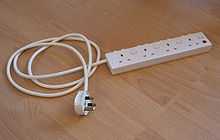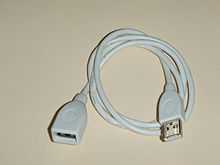Extension cord

An extension cord, power extender, or extension lead is a length of flexible electrical power cable (flex) with a plug on one end and one or more sockets on the other end (usually of the same type as the plug). The term usually refers to mains (household AC) extensions but is also used to refer to extensions for other types of cabling. If the plug and receptacle are of different types, the term "adapter cord" may be used. Extension cable is also used, but that has a distinct meaning from extension cord for many people. Most extension cords range from around 2 feet to 30 feet in length.
.jpg)
Overview
Some extension cords also incorporate safety features, such as a polarized plug and receptacle, grounded terminals, a 'power-on' indicator, a fusible link, or even a residual-current device (also known as a ground-fault circuit interrupter or GFCI).
Extension cords come in various colors, lengths, thicknesses and service duties. In general, the more power needed by the appliance, the thicker the cord should be (that is, larger wires inside). Cords to be used outdoors, in wet areas, around oils, or exposed to sunlight for long periods should be selected for such specific service. An extension reel is an extension lead that rolls up, usually into the socket end, which in some cases has more than one socket on it (often 2 or 4). Another type of extension reel hangs near the plug end and permits the user to draw the cord out by grasping the socket end.
Some cords contain multiple female connectors. Others have female connectors spaced along the length of the cord. Cords generally contain either grounded or ungrounded connectors. While a grounded male connector can be forced into an ungrounded female socket, this is unsafe,
A power cord is similar but much shorter and designed to connect an appliance to a mains outlet. The female end mates with an appliance inlet.

A power strip is a block on the end of a power cable with a number of sockets (usually 3 or more), often arranged in a line. This term is also used to refer to the whole unit of a short extension cord terminating in a power strip.
The term "extension cord" has been in use since at least 1946.
Restrictions
To avoid the need to roll-up any excess length, and to avoid the need for the user to cut the cord to size, extension cords are sold in prefabricated lengths 1 to 150 feet (30 cm to 45 m). The longer the cord the larger the diameter of the conductors (wire gauge numbers are smaller for larger diameter wire) should be to minimise voltage drop. Every extra foot of cord increases the electrical resistance, which decreases the power the cord can deliver to connected devices. Because of this, it is best to use a cord that's exactly as long as needed and no more.
In the United States where the domestic voltage is 120 V, the National Electrical Code (NEC) prohibits the use of extension cords in a 20 A circuit unless they are of 16 AWG or larger diameter (for example, 14 AWG or 12 AWG). As with other flexible cords, the NEC also prohibits their use where attached to building surfaces, or concealed inside walls, floors, or ceilings, above suspended ceilings, or where run through holes or other openings (windows, doors) in structures (with limited exceptions). Cords run across the floor should be covered with a suitable device to protect them from physical damage.
| Conductor gauge/wires: |
Max amps: |
Max length: |
|---|---|---|
| 16/2 | 13A | 50' |
| 10A | 100' | |
| 16/3 | 13A | 50' |
| 10A | 100' | |
| 14/3 | 15A | 50' |
| 13A | 100' | |
| 12/3 | 15A | 100' |
| 10/3 | 15A | 100' |

Within the United States, Underwriters Laboratories certifies extension cords as complying with the NEC. Key standards are UL 817[2] for the entire extension cord, and UL 62[3] for the electrical cabling itself. The United States General Services Administration also maintains a standard for extension cords, J-C-1270,[4] that references the UL standards and provides additional criteria.
Other countries also regulate the use of extension cables but the specific conditions and the nature of the regulation varies. In Europe and elsewhere where the normal domestic voltage is around 230 V, there is less risk of causing fire through overheating of cables for any given power due to the lower current. However most European extension reel cables now include an automatic current cut-out to avoid misuse of the cable. This requires manual re-setting if excess current is drawn through the cable. (American multi-plug cords also include such a device but single- or triple-outlet cords do not.)
An extension reel can only be used to carry full rated current when fully extended since the portion on the reel constitutes a concentration of the loss power (the result of its series resistance) which is not suitably dissipated unless most of the cable is unreeled to expose it to ambient air.
Fire hazard
Fire incident history research has shown that a large proportion of structure fires are caused by extension cords that have been either damaged or overloaded. The insulation of extension cords, particularly light-duty two-wire cords typically used in residences for powering things like lamps, clocks, radios, and portable fans, is easily damaged by being pinched between furniture and floors or walls or by being crushed or abraded by foot traffic. The cords can also be damaged at the plug and socket connections by being accidentally over-tensioned (pull on excessively), which sometimes happens when people trip on them. Overloading can cause an extension cord to heat up to the point that its insulation either melts or carbonizes. Also, if the internal metal wires are damaged, such as by the cord being crushed in a door, then where the unbroken part of the wires is narrower than the bulk of the wires, this can form a point of high resistance which can cause a hot spot to develop, as the resistance of the narrower part of the wire is higher than the rest of the wire and so tends to concentrate power dissipation there. Heating appliances may also cause heat damage to the insulation of a cord, melting or burning it away. Finally, animals, whether they be pets or invading pests, may chew on the wires and remove some of the insulation. In any of these cases, if the damage is not noticed and the cord is not repaired or taken out of service, the damage can lead to arcing or a short circuit between the wires, which can cause a large amount of heat that can ignite nearby materials. The exposed wires of an extension cord that has damaged insulation can also present a shock hazard to people and animals (e.g. pets).
One of the main reasons that the NEC requires that there be a receptacle within six feet of every point along a wall in residences is to reduce the need for extension cords, so as to reduce the potential fire hazard associated with extension cords. However, even in houses with more receptacles than the Code requires, there will sometimes be a need for extension cords. The cords can be used safely in any residence, even very old houses with few receptacles located far apart, if adequate care and attention is given to their use. This includes routing extension cords away from where they are likely to be damaged, using the shortest cord that will serve each intended purpose, and, not the least, examining the cords periodically for damage or signs of overloading (melting deformation, darkening in color, or a "burnt" or "electrical" smell). Periodic inspection is especially important for cords that may be used in place for a long time, for instance behind furniture, where damage may go unnoticed for a long time, perhaps years, before by chance conditions are right for a fire or electrical shock incident to occur (e.g. some dust or paper falls near the arcing wire, or a liquid spill occurs and flows to the exposed wire). Another dangerous modification to an extension cord is removing the third prong in order to fit sockets, which results in removing of the grounding prong.
Signal cable extenders

Extension cords sometimes refer to cables that add to the length of signal transmission cables or combined signal/electrical cables (for example, USB cables). They are more likely to be called "extenders" or "extender cables" or "cable extenders". Such extenders have one male and one female connector.
Passive USB extender cables do not meet the USB standards and thus are forbidden to carry the USB logo. The only cable type that is recognized by the official USB standards is one with an A plug and a B plug (either regular or mini-B) at either end. This restriction was intended to prevent cable lengths greater than the maximum allowed by the USB standard from being assembled and to avoid an accumulation of resistance in the connections exceeding the design limts of USB, in order to ensure consistent plug-and-play operation of the USB system without the need for users to calculate cable lengths or enforce technical rules. The intention of USB is that any standard-compliant cable can be used to connect any two compatible devices, and the connection will work, without question. To this end, the USB standard limits the maximum length of any compliant (and thus logo-bearing) USB cable (to about 15 feet), and up to this length, users are expected to buy a longer cable rather than extending a shorter one they already have. For a longer cable length, a USB hub is required. However, if one chooses to forego the "no technical knowledge needed" aspect of USB and think as an engineer, it is possible to use passive USB extender cables to assemble a cable length approaching 15 feet and use it without problems. Despite being nonstandard, these extender cables are readily available from many sources.
Another class of USB extenders are actually USB hubs with a length of cable permanently attached. These do comply with the USB standard, if not more than a limited number of them are connected together. However, they require power from the USB connection and so may reduce the power available for the device at the "B" end.
Lead content
Extension cords sold in the United States may contain lead in the PVC insulation sheathing. California Proposition 65 (1986) requires manufacturers to warn consumers when products contain toxic chemicals. Many extension cords carry warning labels that advise consumers to wash their hands after handling them.
The European directive, RoHS, restricts the use of hazardous materials like lead in the manufacture of electrical products such as extension cords. Some manufacturers have moved to RoHS compliance but there is currently no widespread movement in the USA to stop the manufacture of products containing lead.
See also
References
- ↑ Coleman Cable Inc.
- ↑ UL 817 (2001-03-16). "Standard for Cord Sets and Power-Supply Cords". Retrieved 2011-09-26.
- ↑ UL 62 (2010-05-18). "Flexible Cords and Cables". Retrieved 2011-09-26.
- ↑ J-C-1270B (1973-10-05). "Cable Assembly, Power, Electrical". Retrieved 2011-09-26.
External links
- Extension Cords at Underwriters Laboratories Inc
- A solution to the socket shortage? BBC News article